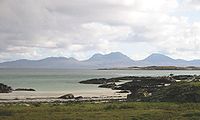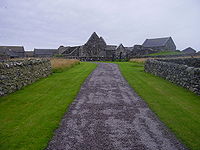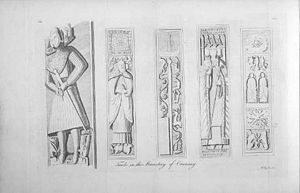
Oronsay, Inner Hebrides
Encyclopedia
Oronsay also sometimes spelt and pronounced Oransay by the local community, is a small tidal island
south of Colonsay
in the Scottish
Inner Hebrides
with an area of just over two square miles.
 It rises to a height of 93m (305 feet) at Beinn Orasaigh (Beinn Oronsay) and is linked to Colonsay by a tidal causeway
It rises to a height of 93m (305 feet) at Beinn Orasaigh (Beinn Oronsay) and is linked to Colonsay by a tidal causeway
(called An Traigh ('The Strand')) consisting of sands and mud flats
. In the 2001 census Oronsay was recorded as having a population of five people, who live at the farm adjacent to Oronsay Priory
. The island has no facilities of its own, and is entirely dependent upon its tidal access to and from Colonsay. The rocks and skerries of Eilean nan Ròn (Seal Island), to the south-west, are an important Grey Seal
breeding colony. In order to conserve the population of resident Chough
s and breeding Corncrakes Oronsay and southern Colonsay became a Special Protection Area
in December 2007.
There are two theories for the origin of the name from Old Norse
. Either it is Oran's Isle, St Oran being the founder of the island's monastery in 563, or it may be from the Old Norse Örfirisey
meaning "island of the ebb tide".
was informed that, "Macdufie
was a factor or manager for Macdonald King of the Isles
upon these islands of Oransay and Colonsay & that for his mismanagement & tyranny he was executed by order of that prince".
It is now owned by the Colburn family.
 The island is best known for Oronsay Priory
The island is best known for Oronsay Priory
, a 14th century ruined Augustinian
priory
, probably on the same site as the original 563 building, and the Oronsay Cross, originally carved on Iona
. The Priory was modest in scale, but has one of the most complete (though somewhat restored) cloister garths of any Scottish medieval religious house. In the late Middle Ages a distinct 'school' of monumental sculpture flourished on Oronsay, leaving many slabs with effigies or other carvings at the Priory itself, or at other religious sites throughout the Hebrides to which they were exported. See examples pictured below. The production of sculpture ceased at the Scottish Reformation
.
Oronsay is one of several Hebridean islands that have furnished archaeologists
with invaluable information about the Mesolithic
period of prehistory
, particularly about the diet of human beings.


Tidal island
A tidal island is a piece of land that is connected to the mainland by a natural or man-made causeway that is exposed at low tide and submerged at high tide. Because of the mystique surrounding tidal islands many of them have been sites of religious worship, such as Mont Saint Michel with its...
south of Colonsay
Colonsay
Colonsay is an island in the Scottish Inner Hebrides, located north of Islay and south of Mull and has an area of . It is the ancestral home of Clan Macfie and the Colonsay branch of Clan MacNeill. Aligned on a south-west to north-east axis, it measures in length and reaches at its widest...
in the Scottish
Scotland
Scotland is a country that is part of the United Kingdom. Occupying the northern third of the island of Great Britain, it shares a border with England to the south and is bounded by the North Sea to the east, the Atlantic Ocean to the north and west, and the North Channel and Irish Sea to the...
Inner Hebrides
Inner Hebrides
The Inner Hebrides is an archipelago off the west coast of Scotland, to the south east of the Outer Hebrides. Together these two island chains form the Hebrides, which enjoy a mild oceanic climate. There are 36 inhabited islands and a further 43 uninhabited Inner Hebrides with an area greater than...
with an area of just over two square miles.

Causeway
In modern usage, a causeway is a road or railway elevated, usually across a broad body of water or wetland.- Etymology :When first used, the word appeared in a form such as “causey way” making clear its derivation from the earlier form “causey”. This word seems to have come from the same source by...
(called An Traigh ('The Strand')) consisting of sands and mud flats
Mudflat
Mudflats or mud flats, also known as tidal flats, are coastal wetlands that form when mud is deposited by tides or rivers. They are found in sheltered areas such as bays, bayous, lagoons, and estuaries. Mudflats may be viewed geologically as exposed layers of bay mud, resulting from deposition of...
. In the 2001 census Oronsay was recorded as having a population of five people, who live at the farm adjacent to Oronsay Priory
Oronsay Priory
Oronsay Priory was an Augustinian monastic community on the island of Oronsay, Inner Hebrides. It was in existence by 1353, perhaps founded by John of Islay, Lord of the Isles. It was dedicated to St Columba, and perhaps was a continuation or a re-activation of an older establishment...
. The island has no facilities of its own, and is entirely dependent upon its tidal access to and from Colonsay. The rocks and skerries of Eilean nan Ròn (Seal Island), to the south-west, are an important Grey Seal
Grey Seal
The grey seal is found on both shores of the North Atlantic Ocean. It is a large seal of the family Phocidae or "true seals". It is the only species classified in the genus Halichoerus...
breeding colony. In order to conserve the population of resident Chough
Chough
The Red-billed Chough or Chough , Pyrrhocorax pyrrhocorax, is a bird in the crow family; it is one of only two species in the genus Pyrrhocorax...
s and breeding Corncrakes Oronsay and southern Colonsay became a Special Protection Area
Special Protection Area
A Special Protection Area or SPA is a designation under the European Union Directive on the Conservation of Wild Birds.Under the Directive, Member States of the European Union have a duty to safeguard the habitats of migratory birds and certain particularly threatened birds.Together with Special...
in December 2007.
There are two theories for the origin of the name from Old Norse
Old Norse
Old Norse is a North Germanic language that was spoken by inhabitants of Scandinavia and inhabitants of their overseas settlements during the Viking Age, until about 1300....
. Either it is Oran's Isle, St Oran being the founder of the island's monastery in 563, or it may be from the Old Norse Örfirisey
Oronsay
This is a list of islands called Oronsay , which provides an index for islands in Scotland with this and similar names. It is one of the more common names for Scottish islands. The names come from Örfirisey which translates from Old Norse as "tidal" or "ebb island"...
meaning "island of the ebb tide".
History
On a visit to Colonsay in the 18th century, Sir Joseph BanksJoseph Banks
Sir Joseph Banks, 1st Baronet, GCB, PRS was an English naturalist, botanist and patron of the natural sciences. He took part in Captain James Cook's first great voyage . Banks is credited with the introduction to the Western world of eucalyptus, acacia, mimosa and the genus named after him,...
was informed that, "Macdufie
Clan Macfie
Clan Macfie is a Scottish clan. Since 1981, the clan has been officially registered with the Court of the Lord Lyon, which is the heraldic authority of Scotland...
was a factor or manager for Macdonald King of the Isles
Lord of the Isles
The designation Lord of the Isles is today a title of Scottish nobility with historical roots that go back beyond the Kingdom of Scotland. It emerged from a series of hybrid Viking/Gaelic rulers of the west coast and islands of Scotland in the Middle Ages, who wielded sea-power with fleets of...
upon these islands of Oransay and Colonsay & that for his mismanagement & tyranny he was executed by order of that prince".
It is now owned by the Colburn family.
Archaeology

Oronsay Priory
Oronsay Priory was an Augustinian monastic community on the island of Oronsay, Inner Hebrides. It was in existence by 1353, perhaps founded by John of Islay, Lord of the Isles. It was dedicated to St Columba, and perhaps was a continuation or a re-activation of an older establishment...
, a 14th century ruined Augustinian
Augustinians
The term Augustinians, named after Saint Augustine of Hippo , applies to two separate and unrelated types of Catholic religious orders:...
priory
Priory
A priory is a house of men or women under religious vows that is headed by a prior or prioress. Priories may be houses of mendicant friars or religious sisters , or monasteries of monks or nuns .The Benedictines and their offshoots , the Premonstratensians, and the...
, probably on the same site as the original 563 building, and the Oronsay Cross, originally carved on Iona
Iona
Iona is a small island in the Inner Hebrides off the western coast of Scotland. It was a centre of Irish monasticism for four centuries and is today renowned for its tranquility and natural beauty. It is a popular tourist destination and a place for retreats...
. The Priory was modest in scale, but has one of the most complete (though somewhat restored) cloister garths of any Scottish medieval religious house. In the late Middle Ages a distinct 'school' of monumental sculpture flourished on Oronsay, leaving many slabs with effigies or other carvings at the Priory itself, or at other religious sites throughout the Hebrides to which they were exported. See examples pictured below. The production of sculpture ceased at the Scottish Reformation
Scottish Reformation
The Scottish Reformation was Scotland's formal break with the Papacy in 1560, and the events surrounding this. It was part of the wider European Protestant Reformation; and in Scotland's case culminated ecclesiastically in the re-establishment of the church along Reformed lines, and politically in...
.
Oronsay is one of several Hebridean islands that have furnished archaeologists
Archaeology
Archaeology, or archeology , is the study of human society, primarily through the recovery and analysis of the material culture and environmental data that they have left behind, which includes artifacts, architecture, biofacts and cultural landscapes...
with invaluable information about the Mesolithic
Mesolithic
The Mesolithic is an archaeological concept used to refer to certain groups of archaeological cultures defined as falling between the Paleolithic and the Neolithic....
period of prehistory
Prehistory
Prehistory is the span of time before recorded history. Prehistory can refer to the period of human existence before the availability of those written records with which recorded history begins. More broadly, it refers to all the time preceding human existence and the invention of writing...
, particularly about the diet of human beings.



